Excavation Contractors Brighton
Find top Excavation Company Near Me in Brighton
Get 3 FREE Excavation Contractor quotes for your project today! Compare profiles, reviews, accreditations, portfolio, etc... and choose the best deal.

TNT Excavating
34 reviewsChelsea, 48118, USPonds New and Renewed We specialize in excavating and grading for all types of projects, including ponds, retention/detention maintenance, water features, home site development, land clearing, septic systems, basements, driveways, demolition, building pads, trenching, drainage, and much more! Our passion is to make every project something you're proud of. We offer a wide range of services to meet your needs, including: Ponds New and Renewed Retention/Detention Maintenance Water Features Home Site Development Land Clearing Septic Systems Basements Driveways Demolition Building Pads Trenching Drainage And much more! We also offer full landscaping services through our partners. Contact us today for a free consultation!
- Services
- Why Us?
- Gallery
Get Quote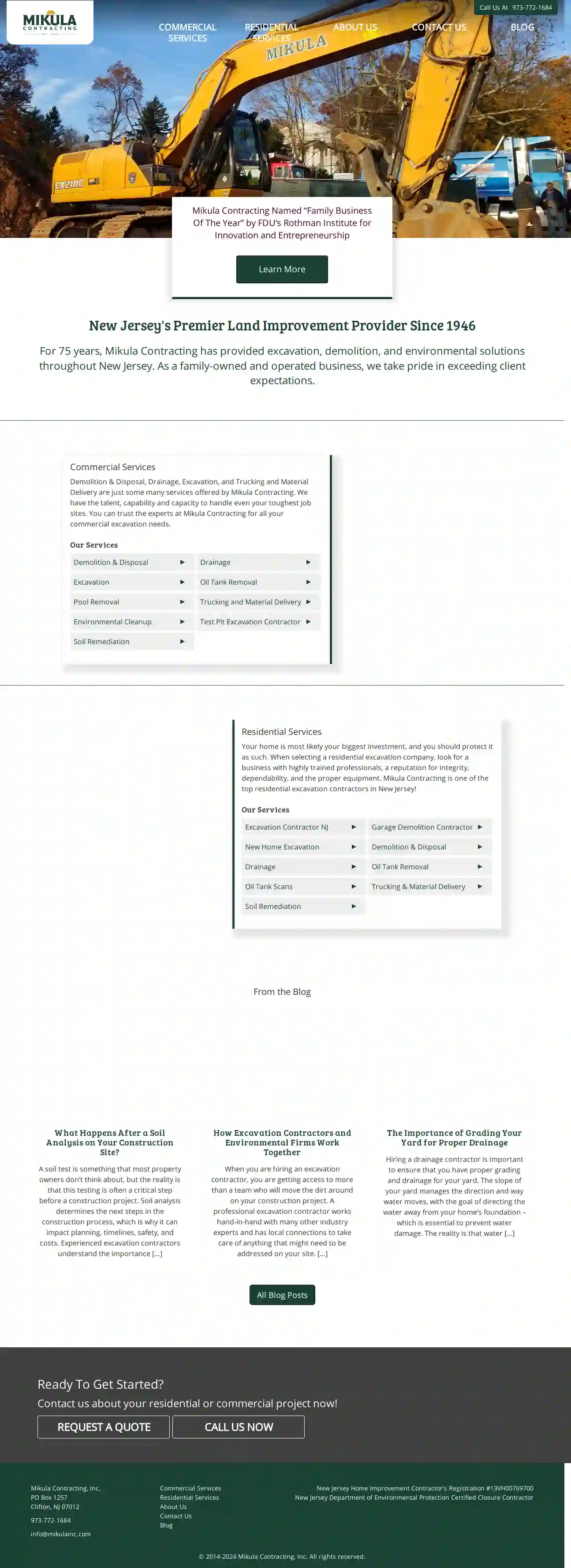
Mikula Contracting
4.855 reviewsPO Box 1257, Clifton, 07012, USAbout Mikula Contracting: A Family Owned and Operated Business Mikula Contracting, Inc., a family owned and operated business, has been servicing all of New Jersey for over 70 Years. We provide commercial and residential customers with a wide range of excavation, demolition, environmental, trucking and soil materials services. Our Founder, Nick Mikula Nick Mikula, Sr. first founded Nick Mikula Excavating with the purchase of a single dump truck in 1946. As the company expanded, it became a corporation in 1968. As a result, it was officially renamed Mikula Contracting, Inc. Nick’s son, Dennis Mikula, Sr., then assumed the leadership role of the company in the early 1980’s. During this time, the company managed to advance with the times and also increase production. All while maintaining the strong work ethic and integrity that Nick initiated. Throughout the years, Mikula Contracting has withstood the many challenges the volatile construction industry has faced, as a result of those values. The Next Generation Including several family members employed by Mikula Contracting, two of whom are Dennis’s sons, there is currently an average of over 13 years of Mikula Contracting service per worker and their experience combined is approaching 200 years. In addition to this extensive experience, each operator is also OSHA certified. It is important to note the extraordinary level of commitment and loyalty of each member of our staff. Their performance levels go above and beyond the standard, thus bettering our company. Trust Factors Mikula Contracting, Inc. is fully insured and certified throughout the state of New Jersey.
- Services
- Why Us?
- Accreditations
- Our Team
- Gallery
Get Quote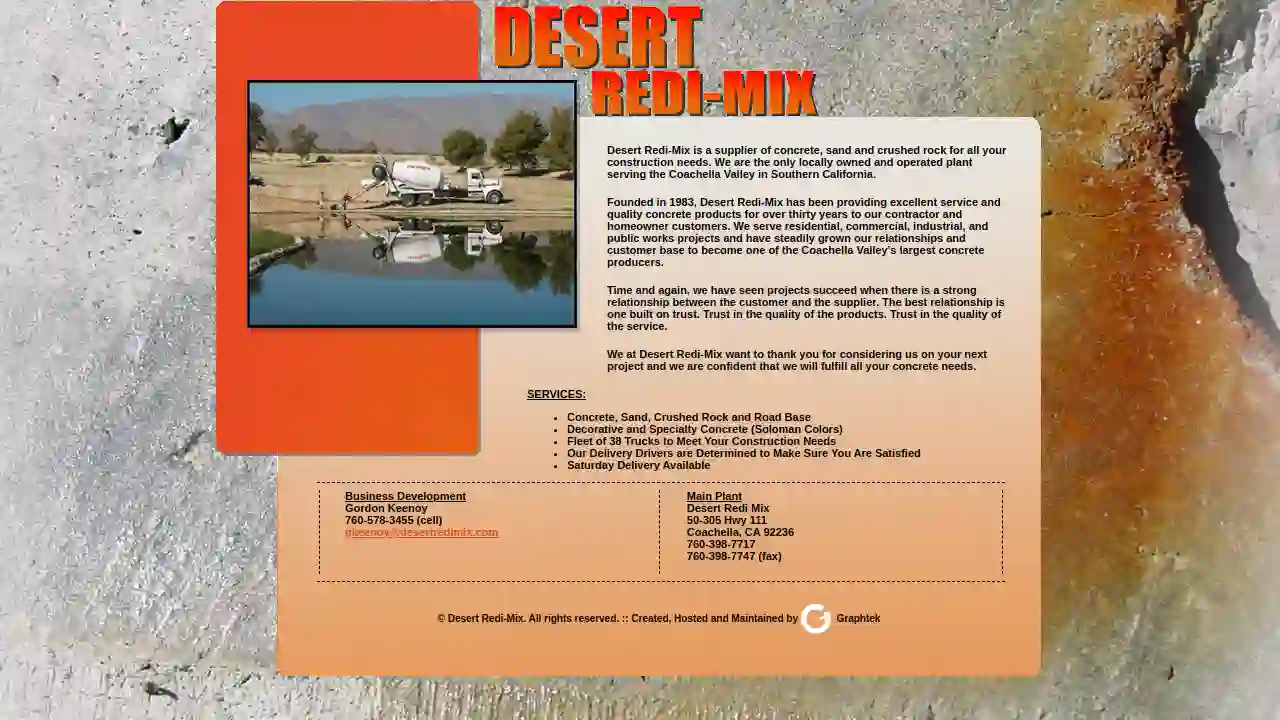
Desert Redi-Mix
34 reviews50-305 Hwy 111, Coachella, USDesert Redi-Mix: Your Trusted Coachella Valley Concrete Supplier Desert Redi-Mix is your go-to source for high-quality concrete, sand, and crushed rock in the Coachella Valley. We're a locally owned and operated company with over 30 years of experience serving the construction needs of homeowners and contractors alike. Since 1983, we've built a reputation for excellence, providing reliable service and top-notch concrete products. We cater to residential, commercial, industrial, and public works projects, and our commitment to customer satisfaction has made us one of the Coachella Valley's leading concrete producers. We understand that successful projects rely on strong partnerships. That's why we prioritize building trust with our customers. Trust in the quality of our products. Trust in the quality of our service. Thank you for considering Desert Redi-Mix for your next project. We're confident in our ability to meet all your concrete needs.
- Services
- Why Us?
- Our Team
- Gallery
Get Quote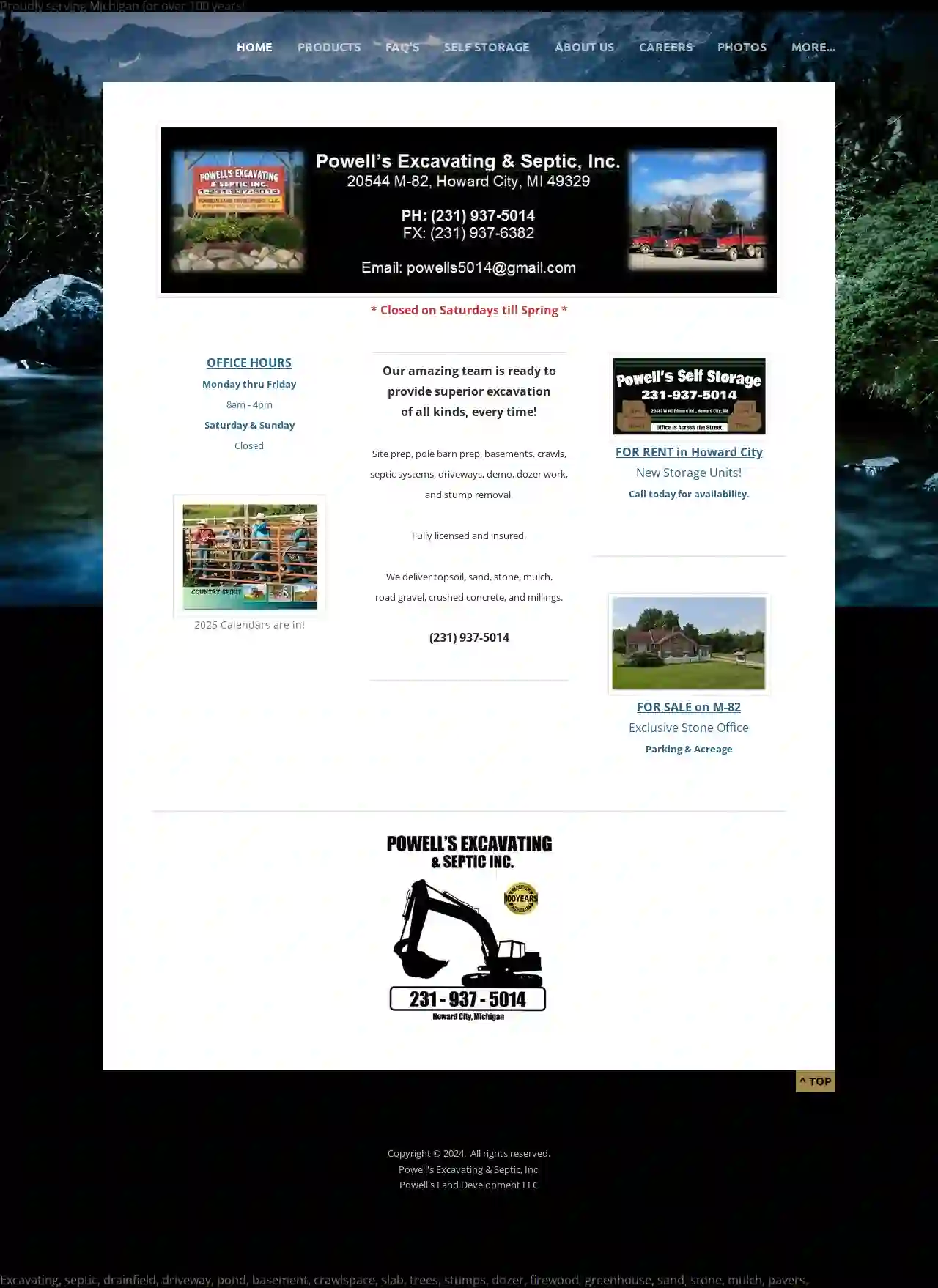
Powell's Excavating & Septic, Inc
4.667 reviews20544 M-82, Howard City, 49329, USPowell's Excavating & Septic, Inc.: A Legacy of Service in West Michigan For over 50 years, the Powell family has been a trusted name in West Michigan, providing high-quality excavation and septic services. It all began in 1968 with Ken Powell and a single backhoe, laying the foundation for a business built on hard work, integrity, and a commitment to customer satisfaction. Ken's dedication to his craft and his family's values instilled a strong work ethic in his sons. As the business grew, his sons, Dave, Ken, and John, each played a vital role in its success. John, with his natural talent for management, took the reins in 1986, ensuring the continuation of the Powell legacy. Today, Powell's Excavating & Septic, Inc. remains a family-owned and operated business, upholding the same high standards and Christian values that have earned them a reputation for excellence. We are proud to serve our community, providing reliable and professional services for all your excavation and septic needs. Whether you're planning a new construction project, need a septic system installed, or require any other excavation services, our team is here to help. We are committed to delivering exceptional results, exceeding your expectations, and building lasting relationships with our clients.
- Services
- Why Us?
- Gallery
Get Quote
Cutting Edge Excavating
4.340 reviews5182 Chicago Dr, Hudsonville, 49426, USTHEN 2009 NOW 2023 Cutting Edge Excavating is a family-owned business founded in March 2009 by the Nykamp family, leveraging their 35 years of combined experience in the excavation industry. We began as a close-knit team of 6, driven by a shared commitment to delivering exceptional excavation services. Our dedication to growth and investment has allowed us to assemble a skilled team of 34 full-time employees. This expansion enables us to provide a comprehensive range of commercial, industrial, municipal, and residential excavation services. We own and operate a fleet of 19 local trucks, ensuring our team has the resources they need to efficiently complete projects of all sizes and complexities. This commitment to in-house equipment and personnel means we can provide our clients with greater control over project timelines and quality. In 2020, we faced a significant setback with a fire destroying our building. However, the unwavering determination of our team fueled a full recovery. We’re proud to call a brand-new facility our home, featuring a spacious 2-story, 9,000 square foot shop and office space, on the same property our old 7,800 square foot warehouse and storage facility stood, in Hudsonville, Michigan. At Cutting Edge Excavating, our mission remains clear: completing your projects on time, professionally, and at a fair price. We look forward to partnering with you on your next excavation project.. The Family
- Services
- Why Us?
- Our Team
- Gallery
Get Quote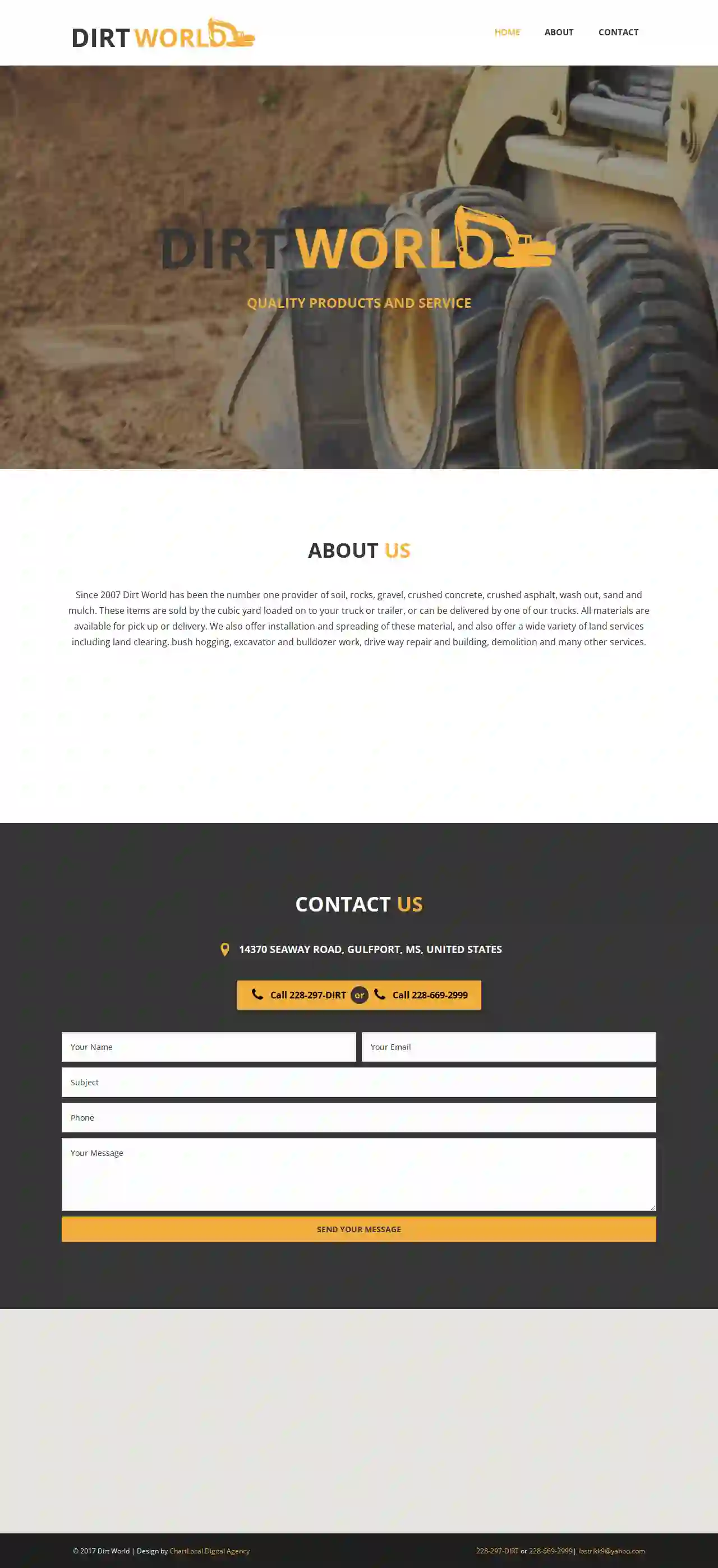
Dirt World
4.232 reviews14370 Seaway Road, Gulfport, USAbout Us Since 2007 Dirt World has been the number one provider of soil, rocks, gravel, crushed concrete, crushed asphalt, wash out, sand and mulch. These items are sold by the cubic yard loaded on to your truck or trailer, or can be delivered by one of our trucks. All materials are available for pick up or delivery. We also offer installation and spreading of these material, and also offer a wide variety of land services including land clearing, bush hogging, excavator and bulldozer work, drive way repair and building, demolition and many other services.
- Services
- Why Us?
- Gallery
Get Quote
Linsley Excavating Inc
59 reviews7610 Division Drive, Battle Creek, 49014, USWelcome to Linsley Excavating, Inc. We're a family owned company that's been around for over 45 years. We've worked in oilfields, subdivisions and commercial properties as well as subcontracting work. We service southwest Michigan. We're a family owned company that's been around for over 45 years. We've worked in oilfields, subdivisions and commercial properties as well as subcontracting work. We service southwest Michigan.
- Services
- Why Us?
- Gallery
Get Quote
Haslock & Sons Excavating Co
4.25 reviews5275 West Coon Lake Road, Howell, 48843, USHaslock & Sons Excavating Co Haslock & Sons Excavating Co is a trusted excavating contractor based in Howell, Michigan. They offer a wide range of services, including excavation, drilling, and boring. They are committed to providing high-quality services at competitive prices. History and Mission Haslock & Sons Excavating Co has been serving the Howell community for many years. They are dedicated to providing their clients with the highest level of service and satisfaction. Their mission is to provide their clients with the best possible excavating services, while maintaining a commitment to safety and environmental responsibility. Services Offered Haslock & Sons Excavating Co offers a wide range of excavating services, including: Excavation Drilling & Boring Grading Trenching & Underground Contractors Well Drilling Team and Experience The team at Haslock & Sons Excavating Co is comprised of experienced professionals who are dedicated to providing their clients with the best possible service. They have a proven track record of success and are committed to exceeding their clients' expectations.
- Services
- Why Us?
- Our Team
Get Quote
Vander Veen Excavating
3.97 reviews6864 Hart Drive, Kalamazoo, 49009, USVander Veen Excavating: Your Trusted Partner for Excavation Services in Kalamazoo, MI Vander Veen Excavating is a well-established excavation contractor based in Kalamazoo, Michigan. With years of experience in the industry, we provide a comprehensive range of excavation services to meet the diverse needs of our clients. Our team of skilled professionals is dedicated to delivering high-quality workmanship, adhering to strict safety standards, and exceeding customer expectations. We understand that every project is unique, and we take a personalized approach to ensure that your specific requirements are met. From site preparation and grading to trenching and utility installation, we handle all aspects of your excavation project with precision and efficiency. At Vander Veen Excavating, we are committed to building lasting relationships with our clients. We believe in open communication, transparency, and providing exceptional customer service. Our goal is to be your trusted partner for all your excavation needs.
- Services
- Why Us?
- Our Team
Get Quote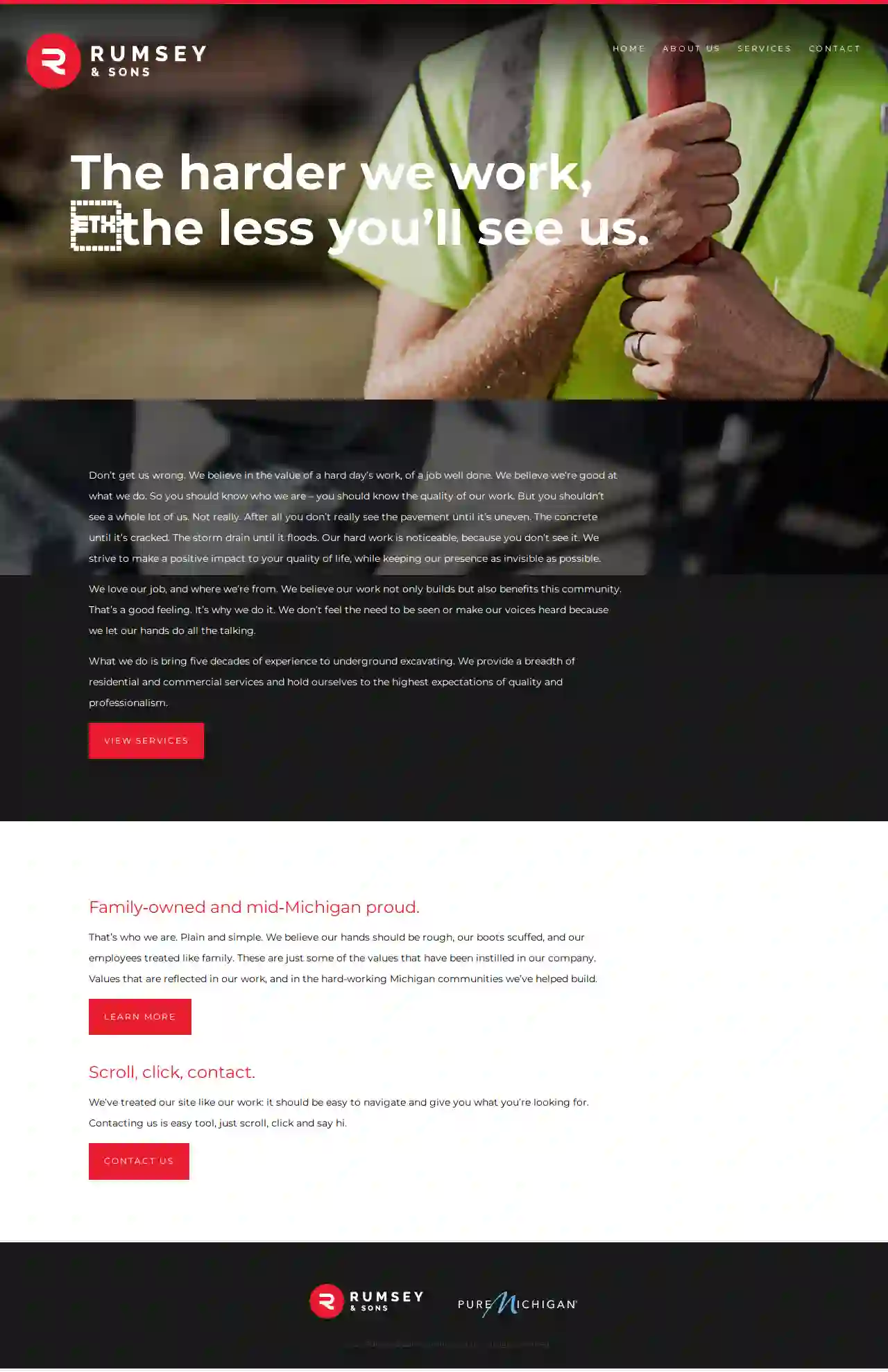
Rumsey & Sons
4.37 reviews6757 Lansing Road, Charlotte, 48813, USRumsey & Sons: A Legacy of Quality and Dedication For over five decades, Rumsey & Sons has been a trusted name in mid-Michigan, providing exceptional excavating, concrete, and earthwork services. Our family-owned business is built on a foundation of hard work, integrity, and a commitment to exceeding expectations. We take pride in our craftsmanship and strive to deliver projects that meet the highest standards of quality and professionalism. Our team is comprised of experienced professionals who are dedicated to providing our clients with the best possible service. We understand the importance of clear communication, timely completion, and a commitment to safety. We are committed to building strong relationships with our clients and ensuring their complete satisfaction. At Rumsey & Sons, we believe in giving back to the community that has supported us for so many years. We are proud to be a part of the growth and development of mid-Michigan, and we are committed to leaving a positive impact on the region. We invite you to learn more about our services and our team. Contact us today to discuss your project needs.
- Services
- Why Us?
- Our Team
- Gallery
Get Quote
Over 22,076+ Excavation Companies onboarded
Our excavation pros operate in Brighton and beyond!
ExcavationHQ has curated and vetted the Best Excavation Companies arround Brighton. Find a top & trustworthy business today.
Frequently Asked Questions About Excavation Contractors
- Excavations Deeper Than a Certain Depth: This varies by jurisdiction, usually around 5 feet.
- Excavations Near Utilities: Digging near buried utilities (gas, water, electric) often requires permits and utility locates to prevent damage.
- Excavations Affecting Public Property: Projects impacting sidewalks, roads, or other public areas typically require permits.
- Excavations in Environmentally Sensitive Areas: Projects in wetlands, floodplains, or other sensitive areas might need special permits.
- Spring and Fall: Often considered favorable due to moderate temperatures and drier soil conditions.
- Summer: Can be suitable, but hot weather can make working conditions challenging and might require additional measures (shade, hydration) for workers.
- Winter: Excavation in winter can be more difficult due to frozen ground, snow, and potential delays caused by inclement weather. It might also require specialized equipment or techniques.
- Clearly Define the Scope: Outline the project's goals, including the excavation area, depth, grade, and intended use.
- Obtain Necessary Permits: Research and acquire any required permits from your local authorities.
- Mark Utility Lines: Contact your utility companies to locate and mark underground utilities to prevent damage.
- Communicate with Neighbors: Inform your neighbors about the project's timeline and potential noise or disruptions.
- Prepare the Site: Clear any obstacles, such as vegetation, furniture, or structures, from the excavation area.
- Discuss Safety Protocols: Review safety procedures with the contractor to ensure a safe work environment.
- Sloped Property: Your property has a significant slope, making it prone to soil erosion or landslides.
- Creating Usable Space: You want to level off a sloped area to create a flat surface for patios, gardens, or other outdoor spaces.
- Preventing Damage: Erosion is threatening existing structures, driveways, or walkways.
- Landscaping Features: You're incorporating tiered gardens, raised beds, or other landscaping elements requiring soil retention.
Do I need a permit for excavation?
What is the best time of year for excavation?
What should I do before excavation starts?
How do I know if I need a retaining wall?
Do I need a permit for excavation?
- Excavations Deeper Than a Certain Depth: This varies by jurisdiction, usually around 5 feet.
- Excavations Near Utilities: Digging near buried utilities (gas, water, electric) often requires permits and utility locates to prevent damage.
- Excavations Affecting Public Property: Projects impacting sidewalks, roads, or other public areas typically require permits.
- Excavations in Environmentally Sensitive Areas: Projects in wetlands, floodplains, or other sensitive areas might need special permits.
What is the best time of year for excavation?
- Spring and Fall: Often considered favorable due to moderate temperatures and drier soil conditions.
- Summer: Can be suitable, but hot weather can make working conditions challenging and might require additional measures (shade, hydration) for workers.
- Winter: Excavation in winter can be more difficult due to frozen ground, snow, and potential delays caused by inclement weather. It might also require specialized equipment or techniques.
What should I do before excavation starts?
- Clearly Define the Scope: Outline the project's goals, including the excavation area, depth, grade, and intended use.
- Obtain Necessary Permits: Research and acquire any required permits from your local authorities.
- Mark Utility Lines: Contact your utility companies to locate and mark underground utilities to prevent damage.
- Communicate with Neighbors: Inform your neighbors about the project's timeline and potential noise or disruptions.
- Prepare the Site: Clear any obstacles, such as vegetation, furniture, or structures, from the excavation area.
- Discuss Safety Protocols: Review safety procedures with the contractor to ensure a safe work environment.
How do I know if I need a retaining wall?
- Sloped Property: Your property has a significant slope, making it prone to soil erosion or landslides.
- Creating Usable Space: You want to level off a sloped area to create a flat surface for patios, gardens, or other outdoor spaces.
- Preventing Damage: Erosion is threatening existing structures, driveways, or walkways.
- Landscaping Features: You're incorporating tiered gardens, raised beds, or other landscaping elements requiring soil retention.
